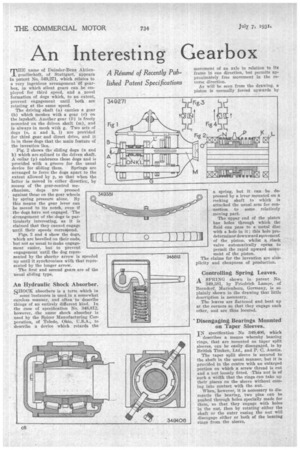An Interesting Gearbox
Page 106

If you've noticed an error in this article please click here to report it so we can fix it.
A Resume of Recently Published Patent Specifications
MILE: name of Daimler-Benz Aktienj_ gesellschaft, of Stuttgart, appears in patent No. 349,271, which relates to a very ingenious arrangement of gearbox, in which silent gears can be employed for third speed, and a novel formation of dogs which, to an extent, Prevent engagement until both are rotating at the same speed.
The driving shaft (a) carries a gear (b) which meshes with a gear (c) on the layshaft. Another gear (11) is freely mounted on the driven shaft (m), and is always in mesh with g. Two sets a dogs (o, n and k, I) are provided for third gear and direct drive, and it is in these dogs that the main feature of the invention lies.
Fig. 2 shows the sliding dogs (n and k) which are splined to the driven shaft. A collar (p) embraces these dogs and is provided with a groove for the usual
device for sliding them. Springs are arranged to force the dogs apart to the extent allowed by p, so that when the latter is moved in either direction, by means of the gear-control mechanism, dogs are pressed against those on the gear wheels by spring pressure alone. By this means the gear lever can be moved to its notch, even if the dogs have not engaged. The drrangement of .the dogs is par ticularly interesting, as it is claimed that they cannot engage until their speeds correspond.
Pigs. 3 and 4 show the dogs, which are bevelled on their ends, but not as usual to make engage
ment easier, but to prevent engagement until the dog represented by the shorter arrow is speeded up until it synchronizes with that represented by the longer arrow.
An Hydraulic Shock Absorber.
SHOCK absorbers is a term which in some instances is used in a somewhat careless manner, and often to describe things of an entirely different kind. In the case of specification No. 348,812, however, the name shock absorber is used by the Spicer Manufacturing Corporation, of Toledo, Ohio, U.S.A., to describe a device which retards the
movement of an axle in relation to its frame in one direction, but permits approximately free movement in the reverse direction.
As will be seen from the drawing, a piston is normally forced upwards by a spring, but it can be depressed by a lever mounted on a rocking shaft to which is attached the usual arm for connection to some relatively moving part.
The upper end of the piston has holes through which the fluid can pass to a metal disc with a hole in it ; this hole predetermines, downward movement of the piston, whilst a clack valve automatically opens to permit the rapid upward movement of the piston.
The claims for the invention are simplicity and cheapness of production.
Controlling Spring Leaves, A SPRING shown in patent No.
349,381, by Friedrich Lampe, of Beendorf, Marienborn, Germany, is so plainly shown in the drawing that little description is necessary.
The leaves are flattened and bent up at the corners so that they engage each other, and are thus located.
• Disengaging Bearings Mounted on Taper Sleeves.
IN specification No 349,406, which describes a means whereby bearing rings, that are mounted on taper split sleeves, can be easily disengaged, is by British Timken, Ltd., and P. C. Austin.
The taper split sleeve is secured to the shaft in the usual manner, but it is provided in the centre with an enlarged portion on which a screw thread is cut and a nut loosely fitted. This nut is of such a width that the rings can take up their places on the sleeve without coming into contact with the nut.
When, however, it is necessary to dismantle the bearing, two pins can be pushed through holes specially made for them, so that they engage with holes in the nut, then by rotating either the shaft or the outer casing the nut will disengage either or both of the bearing rings from the sleeve.




























































































































































